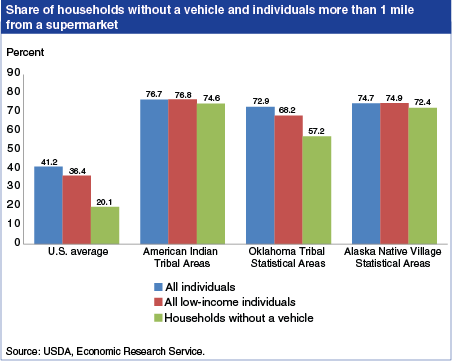Access to supermarkets is limited for many residents in Native American tribal areas
- Contact: Website Administrator
- 12/3/2014

Native Americans living in tribal areas experience high rates of obesity, diabetes, and heart disease that may be due to poor diets. Prior studies cite limited access to supermarkets and other sources of affordable and nutritious foods as contributing factors to less healthful food choices by U.S. consumers. Low population density and limited incomes create disincentives for supermarkets to locate in many tribal areas. In 2010, 74.4 percent of the people in the 545 U.S. tribal areas examined in a recent ERS study lived more than 1 mile from a supermarket, compared with 41.2 percent of the U.S. population. Similarly, among low-income individuals, shares were higher for tribal populations than the national average. Regular access to a car can make traveling to supermarkets easier. However, the share of tribal households without access to a vehicle who lived more than 1 mile from a supermarket ranged from 57.2 to 74.6 percent, versus the 20.1-percent U.S. average. This chart appears in the ERS report, Measuring Access to Healthful, Affordable Food in American Indian and Alaska Native Tribal Areas, released on December 1, 2014.
We’d welcome your feedback!
Would you be willing to answer a few quick questions about your experience?

